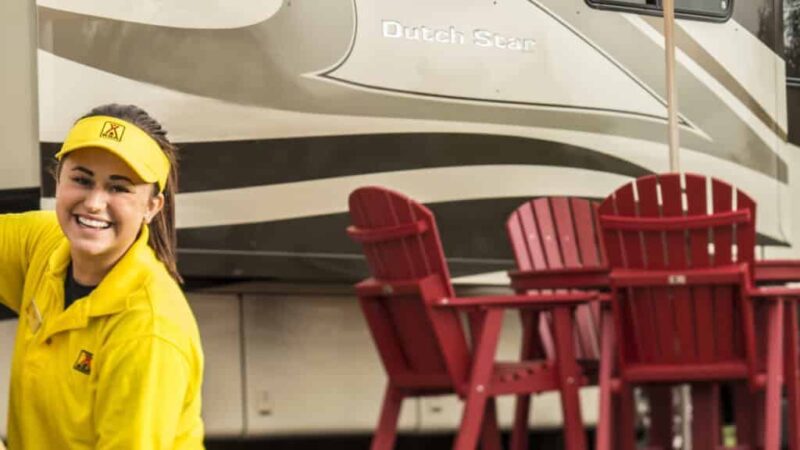Exploring The ’Boro
Statesboro, Georgia, is many things: a college town; a hub of Southern hospitality; a place to discover wildlife, history, culture, and more.
By Kathleen Walls
January/February 2025
Statesboro is one of Georgia’s hidden gems to consider when you plan a winter RV getaway down South. It’s a small town with few traffic problems. Plus, it’s close enough to coastal Georgia and bustling Atlanta for day trips. Afterward, return to a peaceful, less expensive base with lots of things to do, along with a fantastic food scene.
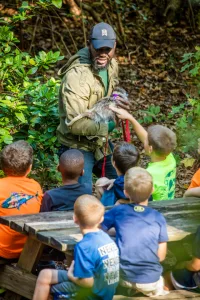
Georgia Southern University’s Center for Wildlife Education showcases critters that call Georgia home.
RVers have two unique and equally comfortable options to use as a home base. One is Beaver Run RV Park (beaverrunrvpark.com) in Metter, about 20 minutes from downtown Statesboro. It offers more than 70 RV sites with water, electric, and sewer hookups, along with free Wi-Fi. The sites are spread along both sides of Beaver Run Lake in a beautiful pine-shaded area, so the campground avoids the crowded feel of many RV parks. A number of sites are pull-throughs.
The clear, spring-fed lake has a beach area for swimming. It’s also great for boating and fishing for bass and bream. Campground guests can play cornhole, horseshoes, shuffleboard, or a round of disc golf, or visit the game room for pool, table tennis, and foosball. Four-legged friends have their own amenities: an off-leash dog park and a dog shower.
Another good camping choice is George L. Smith State Park (gastateparks.org/georgelsmith), about 30 minutes away in Twin City. Its biggest attraction is a covered bridge built in 1880 that also saw duty as a gristmill, cotton mill, and sawmill. A museum at the park documents its history, including the bridge. Another reason to camp here is kayaking on the park’s pristine blackwater lake amid large cypress trees. It’s bird-watcher heaven as well, with the opportunity to spot great blue herons, white ibises, pileated woodpeckers, and more. The campground includes 24 sites with water and electricity; some are pull-throughs. (Editor’s note: At this writing, the park was closed because the area sustained damage from Hurricane Helene in October 2024. Check the park website for updates.)
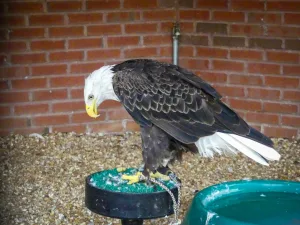
Freedom, a Southern bald eagle, is Georgia Southern University’s mascot.
To explore Statesboro itself, the Statesboro Convention and Visitors Bureau on Main Street makes a good starting point. Out front is a bronze statue of Statesboro’s favorite musical icon, Blind Willie McTell. The blues singer, songwriter, and guitarist is perhaps best known for “Statesboro Blues,” which he recorded in 1928. Inside the building is the Museum on Main, where you can learn about Bulloch County history and pick up maps and information. If you’re in town on the weekend, visit the Statesboro Main Street Farmers Market, located behind the visitor center in a refurbished public warehouse. It’s filled with local produce and crafts every Saturday from April through November.
Georgia Southern University’s Center for Wildlife Education and The Lamar Q. Ball Jr. Raptor Center provides an amazing opportunity to see south Georgia wildlife up close. When we first stepped inside, Steve Hein, executive director of the University Wildlife Center, introduced us to some of the center’s reptile inhabitants. He let us hold a beautiful Burmese python. We met a few birds of prey as well. One was a Harris’s hawk, widely considered the only raptor species that hunts in teams.
Steve escorted us outside through the Wetlands Preserve, where we viewed many other birds in their natural habitats. The duck pond had several species paddling about. One duck was especially gorgeous, with aqua-blue marking around its bill. Steve explained that the coloration was for mating season.
When we walked to the rear of the center, we met Freedom, the university’s mascot. Freedom is a male Southern bald eagle rescued when he was just a few weeks old after falling out of his nest in Maitland, Florida. Audubon Center for Birds of Prey in Maitland wasn’t sure he would survive, as he had an infection and a misshapen beak, and they knew he could not be released back into the wild. Georgia Southern University received permission to acquire him in 2004. (At press time, the Center for Wildlife Education also was closed because of damages from Hurricane Helene.)
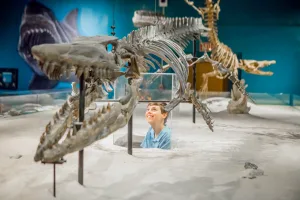
On the GSU campus, Georgia Southern Museum showcases prehistoric and modern fossils.
Besides the wildlife center, GSU features several other attractions in Statesboro you don’t want to miss. For example, Georgia Southern Museum leads you through a visual journey of fossils from prehistoric times to modern Georgia’s Coastal Plain.
One exhibit I found particularly interesting was the skeleton of a young Georgiacetus, a prehistoric ancestor of the whale that had four rudimentary limbs, almost like the feet of a land mammal. Another display showed the difference between a mammoth and a mastodon.
The section about how humans changed Georgia’s Coastal Plain starts with a canoe that was built by pre-Columbian people who traveled and traded with other tribes. Exhibits explain how the white settlers and the native Creeks interacted. The museum takes you through the time of slavery. It tells of the many industries practiced here, from turpentining to oyster harvesting, and their effects on the local people.
Another GSU-sponsored treat is the Botanic Garden at Georgia Southern University, situated on the early-20th-century farmstead of Dan and Catharine Bland. Their home, built of heart pine wood, sits in the middle of the garden. The Weathervane Barn, where they housed their mules, takes you back to 1930s farm life. Each stall is filled with implements used to make turpentine and to grow cotton, tobacco, and produce. The 19th-century Oak Grove one-room schoolhouse portrays how young people learned back then.
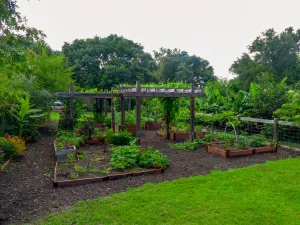
The Botanic Garden at Georgia Southern University educates visitors about 1930s farm life.
The garden is filled with flowers and edible plants. Sections feature huge white hydrangeas, pitcher plants, and vegetables, as well as butterflies and hummingbirds, native plants, and rare and exotic plant species.
Statesboro also boasts a nice supply of art. Averitt Center for the Arts, also home of the Emma Kelly Theater, is the place to go for live performances and a gallery with changing art exhibits. Another venue, the Whitaker Black Box Theater, is located down the street.
To enjoy some free art, check out the murals in town. “River People,” on the west side of the Whitaker Black Box Theater, is a set of five murals representing Native American history of the Archaic period from 2,000 to 4,000 years ago.
“The Fabulous Fifty of 1906” is a mural celebrating the day Statesboro learned it would become a college town. It’s on Main Street next to City Hall and shows the train arriving back in town with the news that Statesboro won the right to be the home of the district’s first agricultural and mechanical school on December 1, 1906. That college later became Georgia Southern University. Both murals were created by artists David Boatwright and Michael Kuffel.
Eagle Nation on Parade is another public art project sponsored by Georgia Southern University. The eagles, a flock of 6-foot-by-5-foot-by-4-inch fiberglass eagle sculptures, all have the same form, but each is painted with a distinct design by different artists. The eagles are designed by Georgia Southern sculpture professor Marc Moulton and former student Daniel Todd. There are 10 so far around Bulloch County.
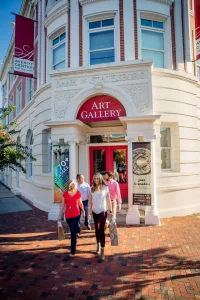
Averitt Center for the Arts offers live performances and a gallery with changing exhibits.
The Main Street Farmers Market has one of the first three eagles painted by artists Colleen Beyer and Wesley Stewart and displays local produce and agriculture. Strangely, it’s at Triangle Park on East Main Street in downtown Statesboro, while the newest eagle, “The City That Soars,” is at the rear of the visitors center near the Farmers Market. The latter is the most realistic looking, painted with natural coloration by Jeff Garland, chair of the Department of Art at Georgia Southern University.
Kayaking at nearby Blackwater Preserve is an amazing experience. It’s filled with cypress trees and so untouched by civilization. A walking trail is marked by vintage tin signs posted on the trees. Watch carefully or you may miss a sign. You’ll see some water birds and hear lots of songbirds. The preserve is open by appointment only; visit blackwaterpreserve.com for more information.
Another watery treat is Splash in the Boro! Family Waterpark, which is open from May to September. Offering more than the average water park, it draws people from all over southeast Georgia. The dual FlowRider is almost like surfing, but the “surfer” remains in place on a flowboard. Other fun includes a kid’s play pool, a wave pool, slides, and a lazy river.
Statesboro offers lots of dining choices. They include Gnat’s Landing, which serves traditional American fare, Cajun/Creole and Mexican cuisine, seafood, soul food, and more. Try the shrimp and grits or “The Bruce,” a hamburger steak with cheese, onions, and gravy.
Barbecue fans have two great choices: Uncle Shug’s and Dolan’s.
For nights when you want an upscale dinner, try Bull and Barrel, famous for their steaks and cocktails, or Tandoor & Tap to enjoy authentic Indian cuisine in a dining area brimming with Indian décor.
For a more adult evening, there’s Vino 1910 for a wine tasting, a beer, or a cocktail, or Eagle Creek Brewing Company, where you can get a craft beer and some great food. I loved their Gata Gata shrimp, a unique take on bang bang shrimp.
Statesboro has transformed from a tiny burg established in 1803 to a charming town of nearly 35,000 today. It offers a perfect mix of activities and sights and is definitely worth a visit the next time you find yourself in the Peach State.
MORE INFO
Statesboro Convention & Visitors Bureau
222 S. Main St.
Statesboro, GA 30458
visitstatesboro.org
(912) 259-9555
The post Exploring The ’Boro appeared first on Family RVing Magazine.
Source: https://familyrvingmag.com/2025/01/01/exploring-the-boro/




